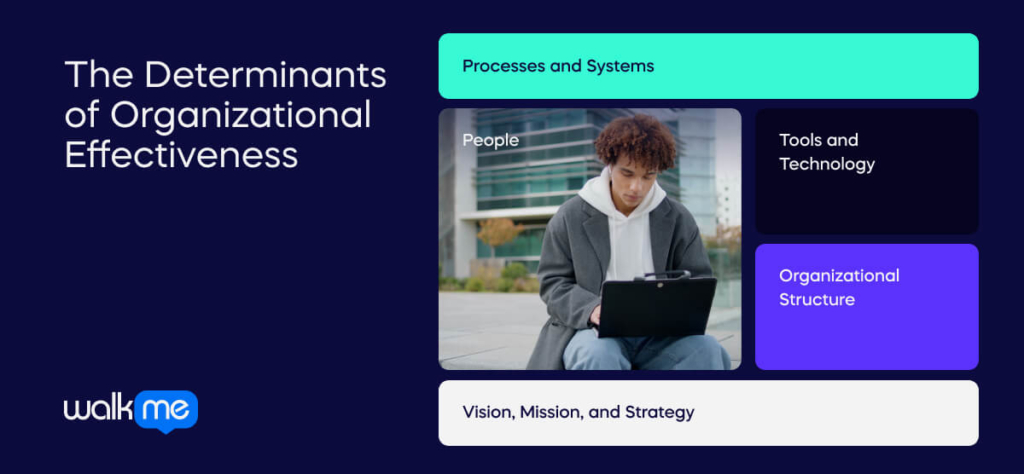What are the biggest determinants of organizational effectiveness?
Below, we will look at some core business functions that fuel organizational success.
Before that, let’s clarify what “organizational effectiveness” actually means.
Organizational Effectiveness Defined
Organizational effectiveness refers to how well an organization can achieve its stated aims.
A business that struggles to meet its objectives and is unprofitable, for instance, could be considered an ineffective organization.
One that operates smoothly and achieves its goals, however, would be an effective organization.
However, organizations are complex entities.
There are many views on what determines and improves organizational effectiveness.
Let’s look at some of the biggest determinants of organizational success.
What Are the Determinants of Organizational Effectiveness?

There are many factors that contribute to an organization’s effectiveness and success.
They include:
People
Employees operate and manage organizations, so it is only natural that their performance will affect an organization’s effectiveness.
These areas can include:
- Skills. Skilled employees are faster, more productive, and more effective.
- Behavior. Organizational behavior can improve employee productivity or detract from it. Employees that are cooperative and driven, for instance, will work better together and produce better results.
- Culture. The culture of an organization is related to behavior. It includes the values, beliefs, and assumptions of an organization. And it affects how they interact, work together, and perform their jobs, among other things.
Among other things.
Processes and Systems
Business processes can be efficient, inefficient, slow, profitable, or a mixture of all of these.
Such processes can include:
- Workflows. An individual employee’s workflow can be efficient, inefficient, or somewhere in between. How efficient that workflow is will affect their contribution to the organization.
- Procedures. Established procedures, such as customer service interactions or internal business procedures, can also be either effective or ineffective.
- Processes. A business process – a set of tasks, procedures, or activities – will also affect the performance of a given business function.
Each organization is unique.
This means that every organization should discover which processes are the most profitable and effective for their unique situation.
Tools and Technology
Another determinant of organizational effectiveness is technology.
The right tools and technology can improve efficiency and results across virtually every business function.
But the wrong tools – or improper use of those tools – can be ineffective and costly.
Examples of tools and technology include:
- Software. The right software, especially at the enterprise level, can make a big impact on business efficiency and effectiveness.
- IT infrastructure. Modern IT systems, such as cloud computing or backend infrastructure, can also affect the speed, efficiency, and effectiveness of many business processes.
- Productivity and training programs. Digital tools can be very beneficial … but only if employees know how to use them properly. Employee training is another essential contributor to business effectiveness.
Today, digital adoption and digital transformation focus heavily on technology and productivity.
That is, digital adoption aims to maximize software productivity and software ROI, rather than merely implementing new technology.
Vision, Mission, and Strategy
Also, an organization’s high-level mission and strategy will determine its effectiveness.
These can include:
- The philosophy of an organization. What does the organization value? Is it strictly focused on profit and competition? Or does it aim to add value to society or its local community?
- Its market positioning. Market positioning – an organization’s strategic position relative to competitors – will also affect organizational efficiency and profitability.
- Organizational strategy. Also, an organization’s high-level strategy will affect how well the company performs within its market, its industry, and among its customers.
All of the above will determine and contribute to many other areas of a business, from its culture to the organizational structure.
Organizational Structure
How an organization is structured will also impact its effectiveness.
Common organizational structures include:
- Top-down. Most of us are familiar with top-down hierarchies and business structures. These include layers such as senior management, middle management, and frontline employees.
- Flat. Flat hierarchies reduce or remove the role of middle management. These structures offer more autonomy and decision-making power to frontline employees.
- Other structures. There are other types of organizational structures, such as matrix structures or multi-divisional structures.
As with every other factor covered here, there is no “best” approach.
In this case, for instance, there is no “best” approach to an organizational structure.
When it comes to organizational effectiveness, what matters most is alignment and synergy.
Final Thoughts: Change Management as a Method for Improving Organizational Performance
As we have seen, the right attributes and business functions can positively impact organizational effectiveness.
However, most organizations don’t improve naturally.
To improve performance, efficiency, and organizational effectiveness, businesses must make intentional changes.
Organizational change management is an ideal solution for improving an organization’s performance and results.
With the right change management approach, a business can target and improve business processes one step at a time.
The results will include businesses that are more efficient, effective, and profitable.

